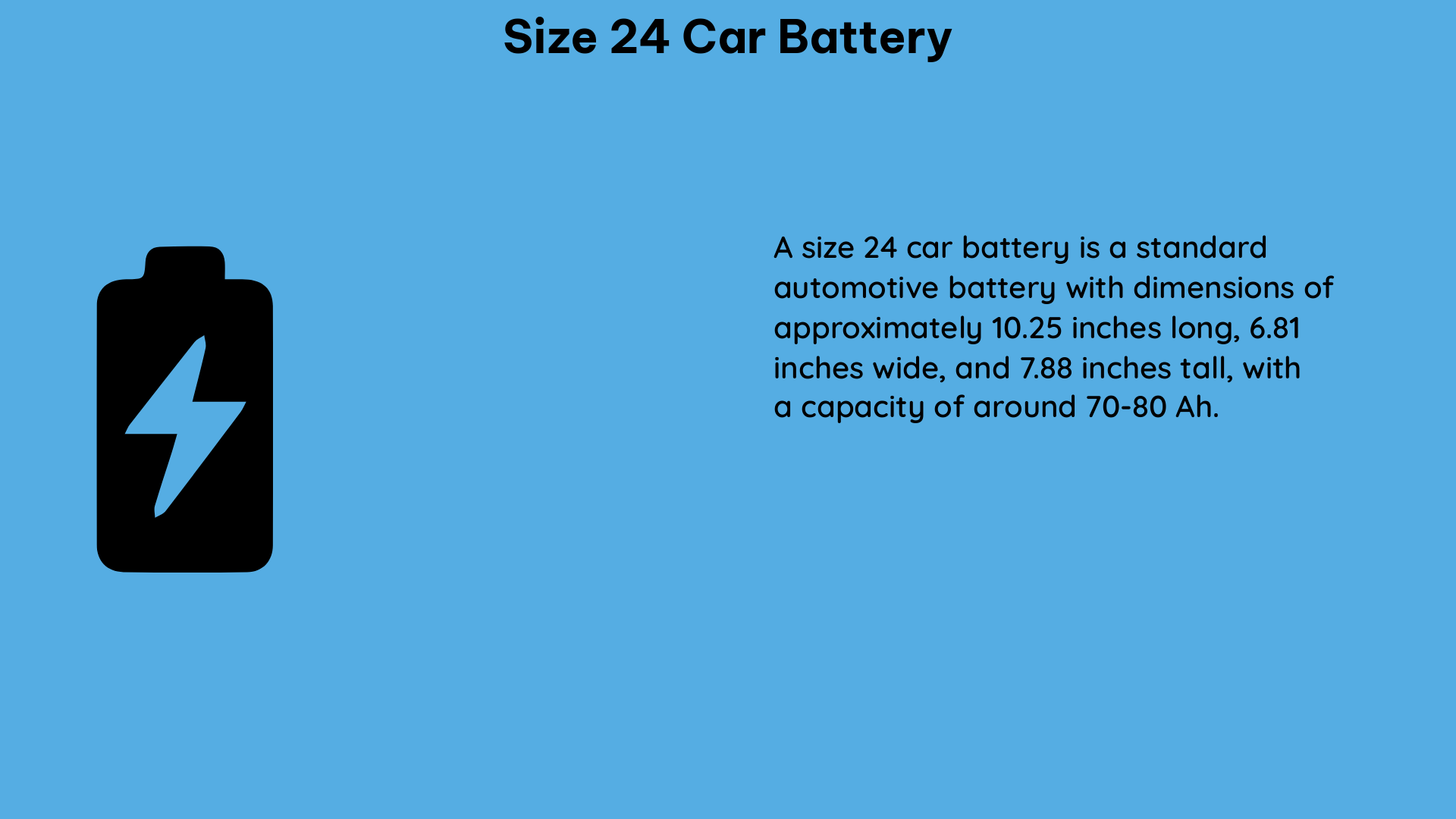The size 24 car battery, also known as a Group 24 battery, is a widely used standard size for automotive batteries. These batteries are designed to provide the necessary power to start and operate a vehicle’s electrical systems, including the engine, lights, and accessories.
Physical Dimensions and Specifications
A Group 24 car battery typically measures 10.2 inches in length, 6.8 inches in width, and 8.3 inches in height. However, it’s important to note that the exact dimensions may vary slightly depending on the manufacturer. The battery’s weight can range from 38 to 45 pounds, with the average weight being around 42 pounds.
In terms of technical specifications, a Group 24 battery has a nominal voltage of 12 volts and a capacity ranging from 60 to 85 ampere-hours (Ah). The cold cranking amps (CCA) rating, which measures the battery’s ability to start an engine in cold temperatures, is typically between 550 and 750 CCA.
Battery Construction and Materials

The construction of a Group 24 car battery typically consists of the following components:
-
Lead-Acid Plates: The battery’s main power-generating components are the lead-acid plates, which are made of a lead-antimony alloy. These plates are arranged in a series of positive and negative plates, separated by insulating separators.
-
Electrolyte: The electrolyte solution, which is a mixture of sulfuric acid and water, is responsible for the chemical reactions that generate the battery’s electrical current.
-
Battery Case: The battery case is typically made of a durable, impact-resistant plastic material, such as polypropylene or polyethylene, to protect the internal components and prevent leaks.
-
Terminal Connectors: The battery’s positive and negative terminals are made of lead or lead-alloy materials, allowing for secure and reliable connections to the vehicle’s electrical system.
Battery Performance and Lifespan
The performance and lifespan of a Group 24 car battery can be influenced by several factors, including:
-
Driving Conditions: Frequent short trips, extreme temperatures, and heavy electrical loads can all contribute to faster battery degradation.
-
Maintenance: Proper maintenance, such as regular cleaning, checking for corrosion, and ensuring the battery is securely mounted, can help extend the battery’s lifespan.
-
Charging System: The vehicle’s charging system, including the alternator and voltage regulator, plays a crucial role in maintaining the battery’s charge and preventing overcharging or undercharging.
On average, a well-maintained Group 24 car battery can last between 3 to 5 years, depending on the usage and environmental conditions.
Replacement and Compatibility
When it comes to replacing a Group 24 car battery, it’s essential to ensure that the replacement battery is compatible with the vehicle’s electrical system and physical dimensions. While it’s possible to use a different battery size, as long as the physical dimensions and terminal types/positions are compatible, it’s crucial to match or exceed the original battery’s CCA rating to avoid potential issues.
To determine the appropriate replacement battery, you can refer to the vehicle’s owner’s manual or consult resources such as the Battery Council International (BCI) Group Sizes database, which provides detailed information on the recommended replacement battery group size for over 160,000 vehicles.
Data Collection and Analysis
Collecting and analyzing data on Group 24 car batteries can provide valuable insights into their performance, usage patterns, and overall reliability. Some methods for data collection and analysis include:
-
Sampling and Measurements: Regularly measuring the battery’s voltage, current, and other parameters can help track its performance over time.
-
Questionnaires and Surveys: Gathering feedback from vehicle owners and mechanics can provide qualitative data on their experiences with Group 24 batteries.
-
Analytics Tools: Using tools like Google Analytics can help analyze usage patterns, such as the frequency of battery replacements and the impact of environmental factors.
-
Open-Source Datasets: Accessing and analyzing publicly available datasets, such as those provided by the Battery Council International, can offer broader insights into the performance and trends of Group 24 car batteries.
By leveraging these data collection and analysis methods, manufacturers, researchers, and vehicle owners can gain a deeper understanding of the performance and reliability of Group 24 car batteries, ultimately leading to improved product design, maintenance strategies, and customer satisfaction.
Conclusion
The size 24 car battery, or Group 24 battery, is a crucial component in the automotive industry, providing the necessary power to start and operate a vehicle’s electrical systems. With its standardized physical dimensions, technical specifications, and construction, the Group 24 battery has become a widely used and reliable choice for many vehicle models.
By understanding the battery’s characteristics, performance factors, and replacement considerations, vehicle owners and mechanics can ensure the optimal performance and longevity of their Group 24 car batteries. Additionally, the collection and analysis of data on these batteries can contribute to ongoing improvements in the industry, benefiting both manufacturers and consumers.
References
- Reddit Discussion on Using a 24 Battery in a 24F Car
- Quantitative Data Examples and Types
- Vehicle Battery Replacement Data – Battery Council International
- BCI Group Sizes – Battery Council International

The lambdageeks.com Core SME Team is a group of experienced subject matter experts from diverse scientific and technical fields including Physics, Chemistry, Technology,Electronics & Electrical Engineering, Automotive, Mechanical Engineering. Our team collaborates to create high-quality, well-researched articles on a wide range of science and technology topics for the lambdageeks.com website.
All Our Senior SME are having more than 7 Years of experience in the respective fields . They are either Working Industry Professionals or assocaited With different Universities. Refer Our Authors Page to get to know About our Core SMEs.